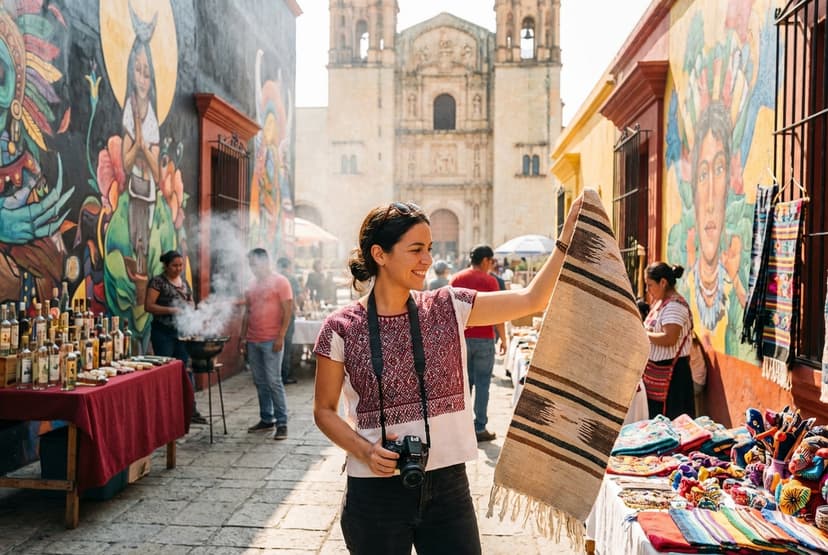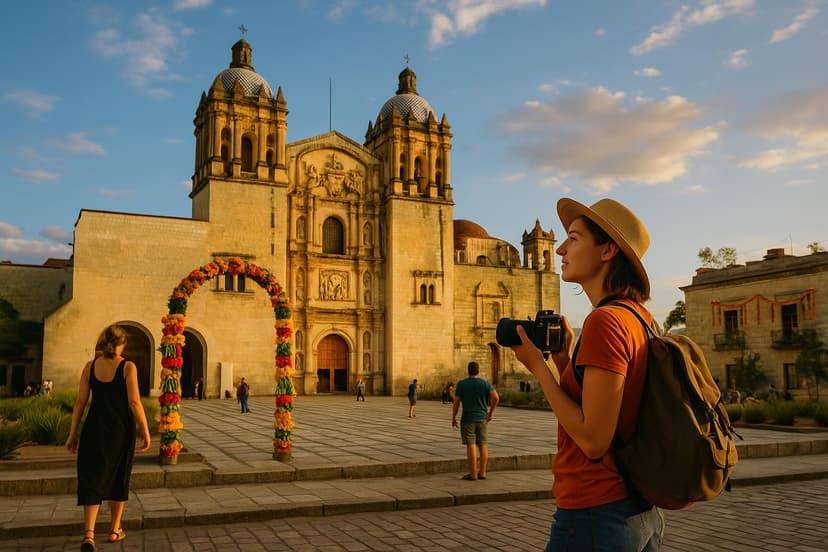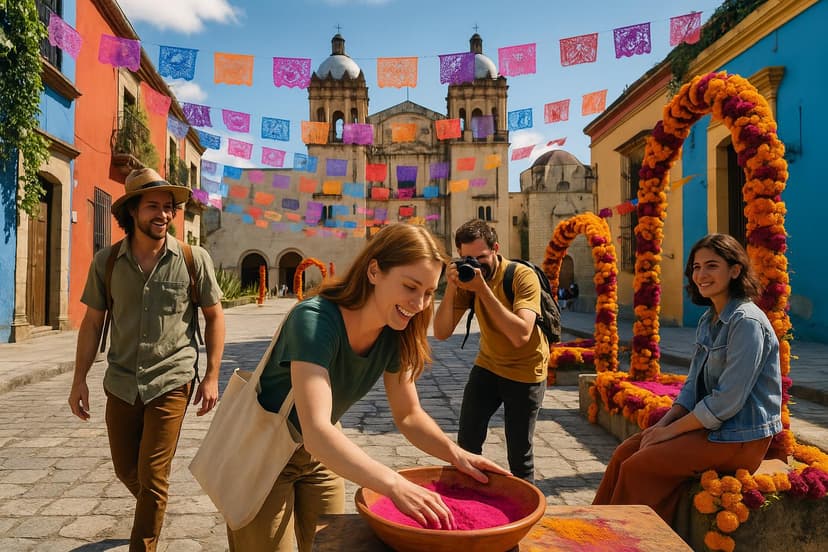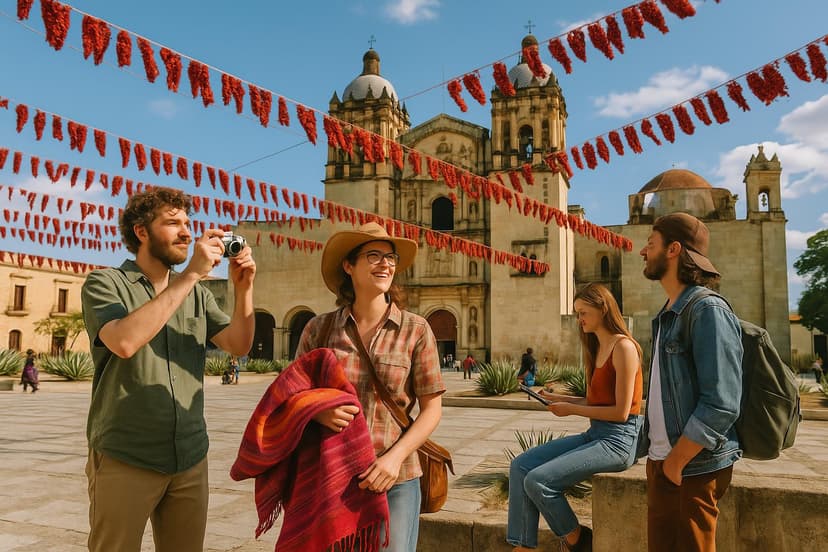Hands-on Oaxaca: Textiles, Alebrijes & Mezcal Studios — 3-Day Artist Retreat

A focused, creative three-day itinerary in Oaxaca for artists who want hands-on encounters with weaving, alebrije carving/painting, and artisanal mezcal. Emphasis on working studios, local markets for materials, plein-air sketching spots and slow tasting sessions — tuned for November (mild days, cool evenings) and an autumn light ideal for plein-air work.
Highlights
- Weaving workshops and natural-dye demos in Teotitlán del Valle
- Alebrije carving & painting sessions in San Martín Tilcajete
- Deep mezcal tasting and palenque visit in Santiago Matatlán
- Plein-air sketching at the Zócalo and Cerro del Fortín
- Sourcing pigments & fibers at Mercado de Abastos and Mercado de Artesanías
- Museo Textil de Oaxaca and Instituto de Artes Gráficas de Oaxaca (IAGO) for local techniques
Itinerary
Day 1
Centro Histórico — textile theory, printmaking, plein-air sketching, and an evening mezcal workshop to begin sensory research.
Museo Textil de Oaxaca (MITEX) — contextual primer on Oaxacan textiles
Start with curated examples of Zapotec and Mixtec weaving techniques, natural-dye samples, and pattern studies to inform your palette and mark-making.
Tips from local experts:
- Ask the curator to point out warp-faced vs. weft-faced techniques — sketch the edge joins for textile-accurate marks.
- MITEX galleries are compact; use a 5x8 sketchbook and pencil to capture motifs quickly before details fade.
- The museum has stairs and some narrow doorways — if mobility is an issue ask staff for the most accessible route to exhibits.
Walk/transfer to IAGO
Short walk through the Santo Domingo precinct to the Instituto de Artes Gráficas de Oaxaca — good time to photograph doorways and street textures for compositions.
Tips from local experts:
- Use this short transfer to do quick thumbnails of street rhythms — 10–15 minute studies.
- Carry a lightweight folding stool or roll-up pad if you prefer to sketch en route.
- Keep sketchbook accessible; Santo Domingo’s carved doors are often best captured in natural morning light.
Instituto de Artes Gráficas de Oaxaca (IAGO) — printmaking & studio visit
Explore live print workshops and historical presses; meeting with printmakers when available to discuss techniques transferable to textile mark-making.
Tips from local experts:
- Bring thin tracing paper to capture an etched plate or carved wood block outline for later translation into weave or stitch.
- If you want hands-on time, request a short demo in advance — many printmakers are willing to show a pull or inking technique.
- The print studios can be humid; protect paper sketches in a zip bag and bring a small weight to hold pages flat.
Transfer to Mercado 20 de Noviembre
Walk to the market for a lively lunch — observe food stalls as pattern and color studies, and scout small tins and containers for material inspiration.
Tips from local experts:
- Use the 15-minute walk to note color temperature changes between shadowed arcades and bright stalls for later palette decisions.
- Bring a small camera or phone with permission to photograph condiment displays as inspiration for saturated swatches.
- Keep an eye on vendor-bought plant material (chilies, spices) that can inspire natural dye experiments later.
Lunch at Mercado 20 de Noviembre — tasting & study
Eat at local fondas; study food textures, woven baskets, and display methods — a living still life for color and arrangement ideas.
Tips from local experts:
- Ask vendors about traditional serving vessels — wooden bowls and banana leaf wrappings make excellent quick sketches.
- Order small plates to sample multiple textures (tlayuda, mole, chapulines) for sensory research connecting taste with color.
- If you collect small discarded packaging, ask permission first — many vendors will happily give you empty containers for collage materials.
Transfer to Zócalo (Plaza de la Constitución)
Walk back toward the center to set up for an afternoon plein-air session at the plaza and cathedral.
Tips from local experts:
- Use this transfer to change to plein-air kit: swap thick sketchbook for watercolor pocket set and a small board.
- Look for shady benches on the route that could be alternate sketching spots if the plaza fills with vendors.
- Carry a lightweight umbrella for late-afternoon sun control — November light is strong and warm.
Plein-air sketching at the Zócalo & Catedral
Two-hour session capturing façade details, market movement, and the fall light — great for compositional studies and tonal notes.
Tips from local experts:
- Set up facing the cathedral a bit off-center to capture asymmetric compositions that translate well into textiles.
- For color notes, paint three small thumbnail washes of the same subject in different palettes (warm, cool, neutral).
- Public restrooms are limited around the plaza; plan materials and water accordingly and remove valuables when crowded.
Coffee & regroup at Boulenc — sketch and annotate
Artist-favorite bakery/café to rest, annotate morning sketches, and prep references for the evening mezcal tasting.
Tips from local experts:
- Sit by the window for consistent light to finish small studies; Boulenc is artist-friendly and often busy but calm inside.
- Use this time to label color mixes and dye notes in your sketchbook while the memory is fresh.
- If you need wall space to tape up a study for later comparison, ask staff — many local cafes welcome artists displaying work briefly.
Transfer to Mezcaloteca
Short transfer to the mezcal tasting library for a guided, sensory-focused session that links raw agave attributes to craft processes.
Tips from local experts:
- Use the transfer to switch from visual to olfactory mode: briefly close your eyes and note city smells to reset the palate.
- Bring a small notebook to record aroma and flavor descriptors — mezcal terminology can feed metaphorical language for work.
- If you have a tolerance or health considerations, let Mezcaloteca staff know; they can adjust pours and focus the session on process rather than quantity.
Mezcaloteca — guided mezcal tasting & studio talk
A structured tasting session led by a mezcal expert; study texture, color and smell parallels to dyes and woody tones used in weaving and carving.
Tips from local experts:
- Tell the host you’re an artist researching pigments — they’ll often highlight agave smoke, soil, and fermentation notes useful for visual translation.
- Sip slowly and take color swatches between pours — the same agave terroir often correlates to muted earthy palettes.
- Evening temperatures in November drop; bring a light jacket for outdoor seating and to keep tasting notes comfortable.
Day 2
Field day in weaving and alebrije villages — hands-on dyeing, weaving and carving/painting sessions with local artisans, plus evening sketching back in the city.
Transfer: Drive to Teotitlán del Valle (weaving village)
Depart early for the Zapotec weaving village to maximize daylight for dye demonstrations and outdoor pattern studies.
Tips from local experts:
- Leave early (in November the mornings are cool) to capture dewy colors and sharper shadows on looms.
- Ask your driver to stop briefly on approach for landscape thumbnails — views of surrounding hills and fields are excellent for compositional backgrounds.
- Bring a portable palette knife to scrape small wool samples (with permission) and label them immediately.
Weaving studio visits & natural-dye demo in Teotitlán del Valle
Spend a focused morning with family-run ateliers: learn backstrap loom set-up, natural-dye baths (cochineal, indigo alternatives), and try your hand at simple loom operations.
Tips from local experts:
- Wear clothes you don't mind getting a little dusty — working looms and dye pits have active surfaces; closed-toe shoes are recommended.
- Collect small labeled swatches from each dye bath for later color-mixing tests in your studio.
- Ask weavers to demonstrate edge-finishing (selvedge) and take a close-up photo; it's often easier to translate into paint strokes than full patterns.
Communal lunch with weaving family / studio (informal)
A simple home-style meal as part of the workshop — a chance to talk technique, patterns' meanings, and to photograph process masters.
Tips from local experts:
- Use lunch time to ask about symbolism in patterns; many motifs have stories that can seed conceptual work.
- Bring small, simple gifts for host artisans (quality thread or sketching materials are appreciated) — avoid bulky packaged items.
- Take notes on fiber hand (how wool feels after washing/dye) as this affects brushwork ideas; tactile memory matters.
Transfer to San Martín Tilcajete (alebrije town)
Short drive to the community known for hand-carved and painted wooden alebrijes — prepare to move from textile rhythm to sculptural surfaces.
Tips from local experts:
- Carry a small set of gouache/inks for on-the-spot color tests against carved wood surfaces.
- Request a stop at a roadside gallery to photograph unvarnished carvings for texture reference.
- Keep a mask or bandana handy if visiting active carving shops — fine dust can accumulate around sanding areas.
Alebrije studio visit & paint-your-own-mini alebrije session
Visit workshops in San Martín Tilcajete to observe carving, then paint a small pre-carved piece under local guidance; study pattern layering and varnish sheen.
Tips from local experts:
- Wear clothing that can handle acrylic or tempera paint splashes; bring small brushes and a portable palette if you have favorites.
- Work from base tones to detail: photograph teachers’ step-by-step layers to replicate varnish-reflective techniques later.
- If sensitive to fumes, request low-VOC paints or work outdoors; many studios will adapt for visiting artists.
Return transfer to Oaxaca city
Drive back late-afternoon; use the journey to catalog references and rest for an evening sketch session.
Tips from local experts:
- Sort and label photos during the drive so images are immediately useful when you return to the studio.
- If you napped briefly mid-ride, you’ll notice shifts in light on return — record those for evening palette choices.
- Ask driver for a drop-off at Macedonio Alcalá to maximize an evening walking sketch opportunity.
Evening sketching on Calle Macedonio Alcalá (pedestrian promenade)
Capture the city’s street life, signage, and shopfronts for narrative details to integrate into mixed-media pieces.
Tips from local experts:
- Set up near a café where you can recharge and use a chair — the boulevard is lively and helpful for people-watching sketches.
- Use a pen-and-wash approach to capture the evening glow quickly; November evenings are cool but not cold.
- Keep a compact folding lamp in your bag if you like finishing small details after sunset; many corners are softly lit, not bright.
Day 3
Materials sourcing and mezcal-depth day: market pigment & fiber hunting, palenque visit in Matatlán, and a closing cultural context stop back in the ex-convent.
Morning at Mercado de Abastos — pigments, fibers & supplies
Explore wholesale stalls for raw pigments, natural dyes, bundles of wool, threads and found objects for collage and mixed media.
Tips from local experts:
- Bring small labeled sample bags and a portable digital scale if you plan to buy bulk pigments or fibers.
- Ask trusted vendors for local names of plants and mordants — jot the Spanish common names for future dye experiments.
- Market aisles are busy; keep sketchbooks and purchases close and use a crossbody bag for security.
Transfer to Santiago Matatlán (Mezcal capital)
Drive to the heart of mezcal country for in-depth palenque visits and a studio-level look at distillation and cooperage.
Tips from local experts:
- Bring earplugs or small noise-cancelling pads if visiting active palenques — some equipment can be surprisingly loud.
- Carry a light scarf to dampen dust and to use as a mask near crushing and fermentation areas.
- Keep spare sketching paper and waterproof pens — palenque visits can be dusty and humidity-variable.
Palenque visit & hands-on mezcal session in Santiago Matatlán
Spend focused time at a small palenque: observe agave roasting, milling, fermentation, and distillation; often includes guided tastings and conversations about local wood, smoke and terroir.
Tips from local experts:
- Photograph textures of charred agave, wooden tools and copper stills — these make great texture references for mixed-media surfaces.
- Ask about seasonal differences in agave harvest; in November the climate affects fermentation times and sugar concentration.
- Respect active work zones and follow the palenque’s safety guidance; closed-toe shoes and long sleeves are recommended.
Lunch in Matatlán — local comedor or palenque meal
Simple, hearty regional lunch paired with a small tasting — a practical time to discuss craft-business practices with producers.
Tips from local experts:
- Use lunch to ask producers about sustainable agave sources — this can inform ethical sourcing for future projects.
- Take notes on presentation and vessels used; many mezcal producers use wooden platters and local pottery which inspire table-top still-lifes.
- Hydrate well; mezcal tastings and the midday sun can dehydrate you quickly.
Return transfer to Oaxaca city
Drive back to town to finish the trip with a cultural synthesis in the ex-convent and a final dinner debrief.
Tips from local experts:
- Sort photos and voice-memo ideas during the drive so you can quickly synthesize work at the next stop.
- If you purchased fragile materials, place them flat in the vehicle to avoid crushing during the return ride.
- Ask the driver to drop you near the Santo Domingo precinct for an easy walk to the ex-convent museum.
Museo de las Culturas de Oaxaca (Ex Convento de Santo Domingo) — cultural synthesis
A contemplative visit to connect archaeological and colonial contexts with contemporary craft traditions — excellent for final research and inspiration photographing textiles, ceramics, and historical motifs.
Tips from local experts:
- Focus on museum labels and provenance notes; lineage and origin of motifs help build narrative layers for your own pieces.
- Use available benches to do compositional thumbnails referencing museum objects with direct scale comparisons.
- Check closing times in November and plan to arrive with at least 90 minutes before close to avoid rushed viewing.
Closing dinner & debrief at Itanoni — corn, memory & palette tying
A final meal centered on heirloom corn preparations to reflect on color, texture and cultural memory; share sketches and notes with your group or guide.
Tips from local experts:
- Use this dinner to compare notes on color and texture observed across studios — candid conversation often sparks new project directions.
- Ask the chef about nixtamalization and how different corn varieties influence color and texture for possible pigment experiments.
- Reserve ahead; November evenings are busy with cultural events and the best tables (with natural light) fill early.




